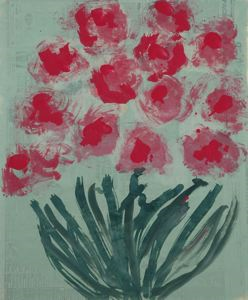
Sybil Gibson
American, 1908–1995
Since her discovery in the late 1960s, Sybil Gibson's work has been exhibited in over 50 one-woman shows. She has been called a "naive" or "primitive" artist because she is essentially self-taught. Faces, flowers, and female figures, particularly little girls, are common elements in her works, though her compositions vary widely in mood from innocent to disturbing.
The painting in the MMFA collection is from Gibson's "late period", after cataract surgery. Works from this time retain the general characteristics of Gibson's earlier works, particularly minimal backgrounds and a lack of detail. Flowers were common subjects throughout Gibson's career though she concentrated on them more heavily in her late works.
American, 1908–1995
Untitled (Floral Arrangement)
1993
Object Type:
Painting
Creation Place:
North America, American, Florida
Dimensions:
27 1/8 in. x 22 5/8 in. (68.9 cm x 57.47 cm)
Medium and Support:
Tempera on paper
Accession Number:
1995.0006.0003
Credit Line:
Gift of Fred and Theresa Buchanan
Since her discovery in the late 1960s, Sybil Gibson's work has been exhibited in over 50 one-woman shows. She has been called a "naive" or "primitive" artist because she is essentially self-taught. Faces, flowers, and female figures, particularly little girls, are common elements in her works, though her compositions vary widely in mood from innocent to disturbing.
The painting in the MMFA collection is from Gibson's "late period", after cataract surgery. Works from this time retain the general characteristics of Gibson's earlier works, particularly minimal backgrounds and a lack of detail. Flowers were common subjects throughout Gibson's career though she concentrated on them more heavily in her late works.
Keywords
Click a term to view the records with the same keyword
Portfolio List
Click a portfolio name to view all the objects in that portfolio
This object is a member of the following portfolios:
Your current search criteria is: Keyword is "W" and [Object]Nationality is "American" and [Object]Century is "Twentieth Century".

 by Artist (7)
by Artist (7)
